Homemade Sourdough Bread, Step by Step
This post may contain affiliate links. Please read my disclosure policy.
If you love fresh sourdough bread with a golden, crisp crust and a light, airy crumb, this recipe is for you. It’s one of the simplest homemade sourdough bread recipes, and one of the best, too. It requires only 25 minutes of hands-on work and no autolyse or preferment. Below you will find guidance for every step of the way. 🍞🍞🍞
⭐️⭐️⭐️⭐️⭐️ Review:
“Absolutely the best sourdough recipe EVER! I have been baking bread for years (sourdough included,) and things were many times hit or miss. Not with your recipe. You have nailed it. I thank you!” — Rosemary Patterson
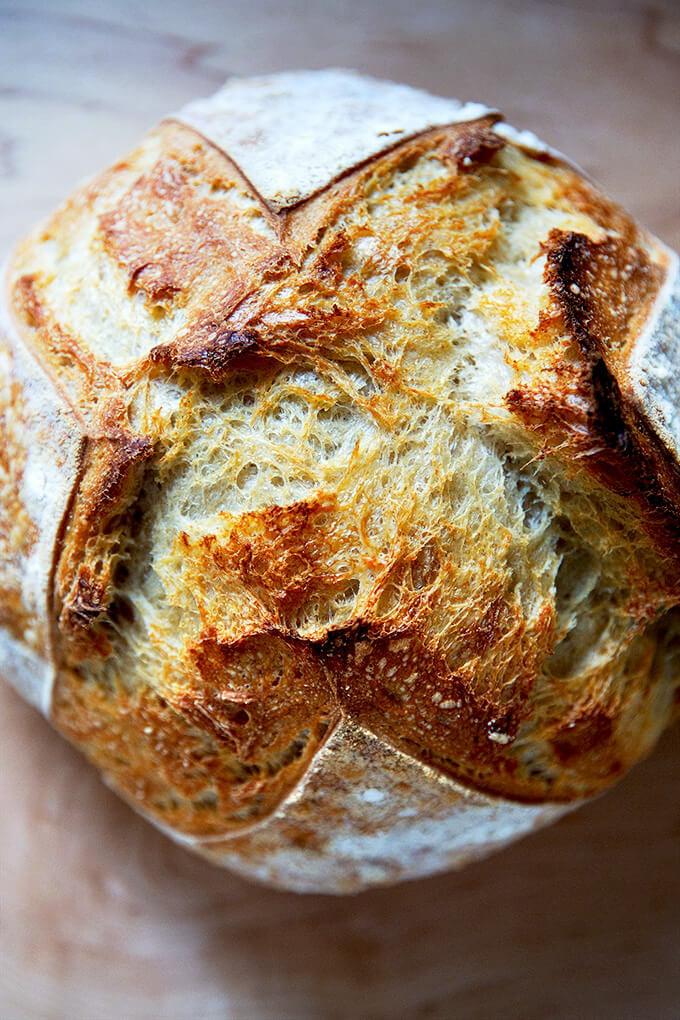
This post will show you how to make the simplest of simple sourdough breads. There is no autolyse or preferment, which means the dough itself comes together in less than five minutes.
For those intimidated by sourdough bread baking, this recipe, as well as this sourdough focaccia recipe, are the recipes I suggest making first, both for their simplicity and flavor. Another great beginner’s bread recipe to try is this overnight, refrigerator focaccia or my mother’s simple peasant bread recipe, both of which require minimal effort but yield spectacular results.
This post is divided into 13 sections:
- What is Sourdough Bread?
- What is a Sourdough Starter?
- How to Feed a Sourdough Starter
- When is My Starter Ready to Be Used?
- Equipment
- How to Make Sourdough Bread: A 5-Step Overview
- How this Sourdough Bread Recipe Differs From Others
- Simple Sourdough Bread: A Step-by-Step Guide
- #1 Sourdough Bread Baking Tip
- Troubleshooting: Where Sourdough Goes Wrong
- Sourdough Baking Resources
- Other Sourdough Bread Recipes to Make
- Sourdough Bread Baking Schedule
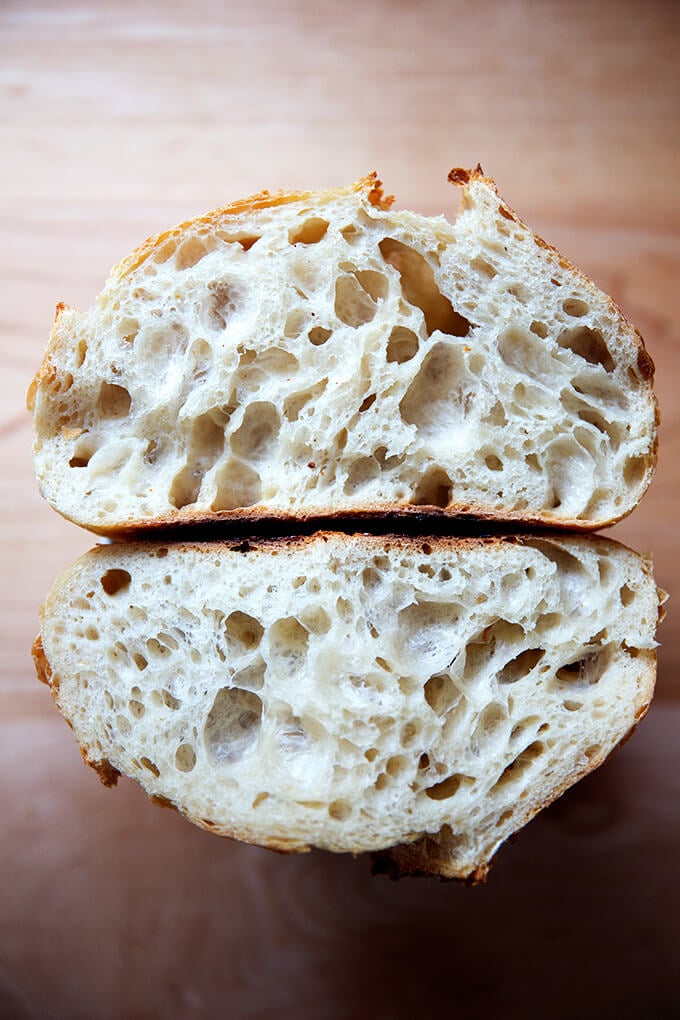
What is Sourdough Bread?
Sourdough bread is bread that has been leavened naturally, meaning it has been leavened by a sourdough starter as opposed to by commercial yeast or a chemical leavening agent such as baking powder or baking soda.
What is a Sourdough Starter?
A sourdough starter is a fermented mix of flour and water containing wild yeast and bacteria (lactobacilli). Provided it is healthy and active, a sourdough starter is what will make your bread rise.
You can make a sourdough starter from scratch in just about a week. I only recommend doing so if it currently is summer (or a very warm fall) where you are. While it is immensely satisfying to build a starter from scratch and subsequently use it to make a beautiful loaf of bread, I am a huge proponent of purchasing one for a few reasons, namely: when you purchase a starter, you are guaranteed to have a strong, vigorous starter from the start. In other words, you can start baking with confidence right away.
Here are three online sources for reasonably priced sourdough starters:
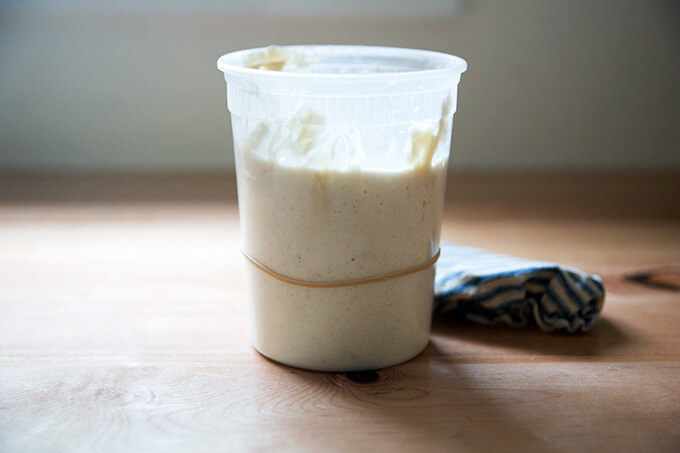
How to Feed a Sourdough Starter
In order to keep your starter alive, you have to feed it — it’s not unlike having a pet, but know this: caring for a sourdough starter is akin to caring for a very low maintenance pet, one that requires feeding only once every two to three weeks to stay alive, but one that requires feeding much more regularly if you like to bake frequently.
When I am not baking regularly, I store my starter in the fridge in the above-pictured vessel with its lid on. As noted above it can hang out there for 2-3 weeks (if not longer) without being touched. To wake it up or activate it, I like to feed it twice before using it. Often I’ll remove it from the fridge after dinner and feed it: this involves discarding most of it and replenishing it with equal parts by weight flour and water. (Please read this post, which explains in detail how to activate, feed, and maintain a starter.)
I will repeat this process in the morning — discard most of it; then replenish it with equal parts by weight flour and water. By midday, or when my starter has doubled in volume, it is ready to be used.
To store your starter, you should feed it, let it rise till it nearly doubles; then cover it and stash it in the fridge for 2 to 3 weeks until you are ready to use it again.
How Do I Know if My Starter is Ready to be Used?
If your starter doubles (or triples!) in volume within 4 to 8 hours after a feeding, it is ready to go. And ideally, you want to use your starter 4 to 8 hours after you feed it or when it has doubled. Every time I feed my starter, I place a rubber band around the vessel it is in to mark its height. This helps me see when it has doubled in volume and is, therefore, ready to be used.
If your starter is not doubling within 4 to 8 hours of feeding it, you should spend a few days strengthening it. This will involve discarding most of it — truly, don’t be afraid to be aggressive with how much you are discarding — and replenishing it with equal parts by weight flour and water. If you do this twice a day for several days, your starter will be in great shape.
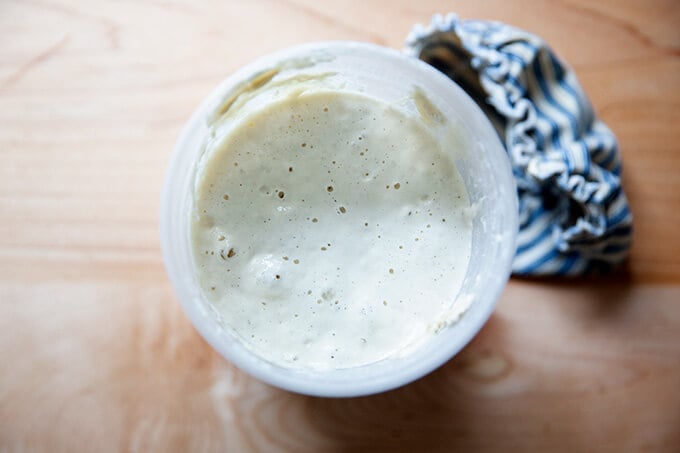
What Equipment Do I Need?
At a minimum, you’ll need:
- a sourdough starter (see above)
- flour, bread flour if possible, my preference is King Arthur Flour
- salt
- water
Ideally, you’ll also have:
- digital scale
- straight-sided vessel for monitoring the bulk fementation
- bench scraper
- flour sack towels
- parchment paper
- banneton, such as this one or this one
- razor blade
- heavy lidded vessel, such as this one or this one
How to Make Sourdough Bread: A 5-Step Overview
There are essentially 5 steps to making sourdough bread. Each of these steps is explained in more detail below.
- Mix the Dough: This is simply a matter of combining water, sourdough starter, salt and flour in bowl, and stirring to form a sticky dough ball.
- Bulk Fermentation: This is just a fancy name for the first rise. During the first two hours of the bulk fermentation, you’ll perform a series of stretches and folds, which will give the dough strength and elasticity.
- Shape + Bench Rest: This step ends the bulk fermentation. You’ll shape the dough, let it rest, then shape it once more.
- Proofing the Dough: In this recipe, you’ll cold proof the dough in the fridge, ideally for 24 to 48 hours, though you can get away with a shorter proof.
- Scoring + Baking the Dough: After the dough has proofed, you’ll turn it out onto a piece of parchment paper, score it; then transfer it to a preheated baking vessel.
How This Sourdough Bread Recipe Differs From Others
This recipe differs from others in three main ways:
- No Autolyse. Why? I’ve never found employing an autolyse makes a big difference in the final texture of the bread, and I find the process of doing an autoylse frankly to be kind of a pain. What is an autolyse? Autolyse is a technique that calls for mixing flour and water together and allowing them to sit for several hours before adding the salt and sourdough starter. This process allows gluten to develop in dough prior to mixing. It also makes the dough more extensible. This is due to the hydrating effects of soaking the flour, as well as — and this is getting a bit scientific — from the enzymatic activity of protease, which breaks down some of the gluten that forms as the dough hydrates. This process weakens the dough’s elasticity, in turn increasing its extensibility. If you are after a super open crumb, autolyse is something to consider.
- 50% (roughly) Increase in Volume. If you come from the yeast-leavened bread world, you are accustomed to letting your dough double in volume during the first rise. When I first got into sourdough, I was applying this same method, and while I had success, I realized I was often letting my dough overferment — I was pushing the bulk fermentation too far. As soon as I stopped the bulk fermentation when the dough increased by 50-75% in volume, I got a much better oven spring.
- Long Cold Proof. After the bulk fermentation, you’ll shape the dough, and store it in the fridge ideally for 24 hours but it can hang out there for 48 hours or even a bit longer. This long, cold proof will make for a much lighter, open, airy crumb. (Note: If you were to leave the dough in the fridge for 12 hours or less, which you can do, the crumb will be tighter and denser.) After you remove the dough from the fridge, you score it, and transfer it immediately to the oven — there is no need to do a room temperature proof first.
Simple Sourdough Bread: A Step-by-Step Guide
Mix the dough.
To start, pour 375 grams of water into a bowl:

Add 50 to 100 grams of sourdough starter.
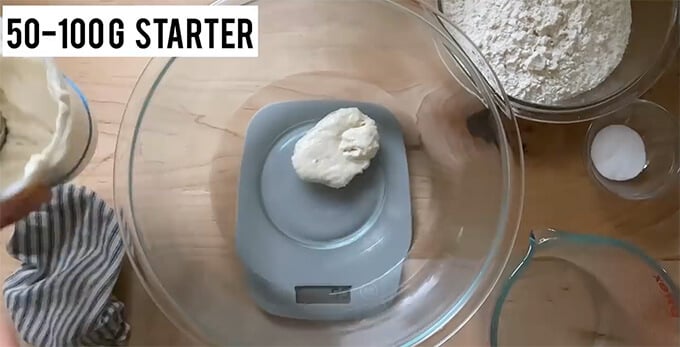
Stir to combine; then add 11 grams of salt:
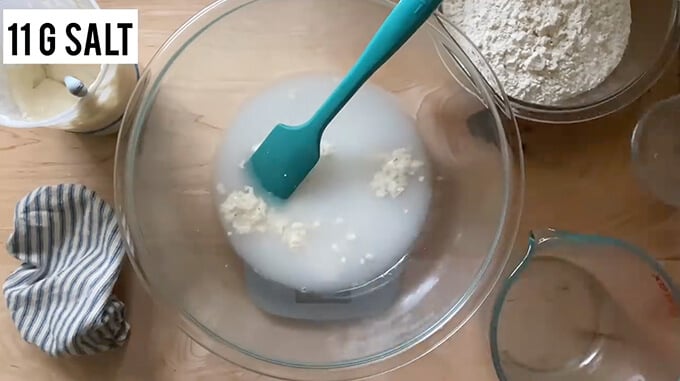
Finally, add 500 grams of bread flour:
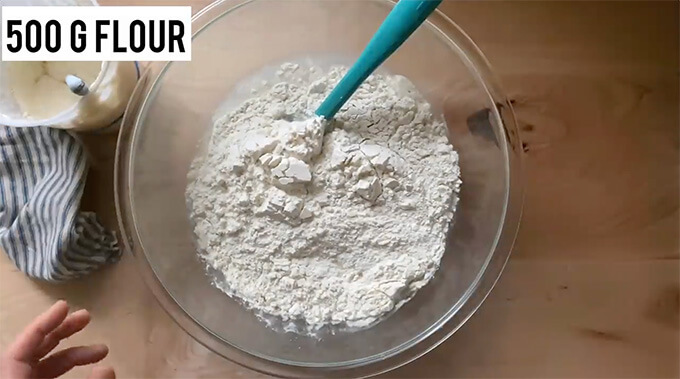
Stir to combine:
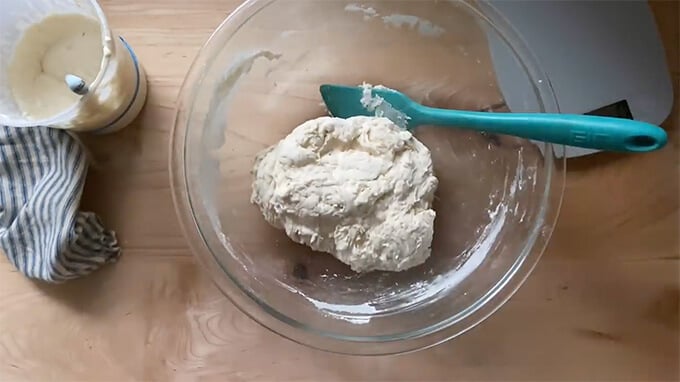
Let it Rise. (Bulk Fermentation)
Transfer the dough to a straight-sided vessel. Cover it, and let it rest for 30 minutes.
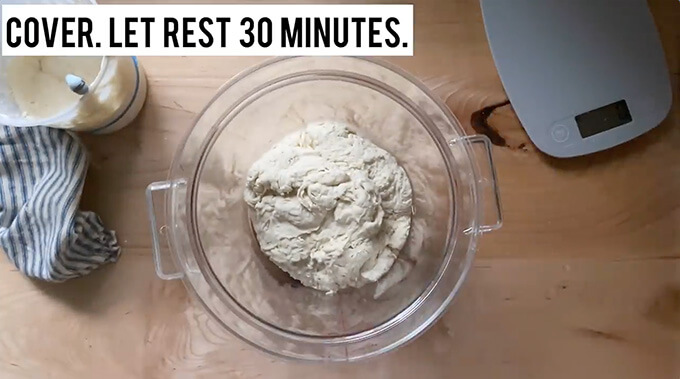
Perform a set of stretches and folds:
If time permits, perform four total sets of stretches and folds every 30 minutes for the first 2 hours. You should notice the dough getting stronger and more elastic with every set of stretches and folds. This is the 4th set:
After the 4th set of stretches and folds, cover the vessel — I love these Dot and Army cloth bowl covers for this — and set it aside until it increases in volume by 50% or so.
How long should the bulk fermentation take?
The time will vary depending primarily on the strength of your starter and the temperature of your kitchen. Rather than rely on a time period, however, you should rely on visual cues.
This video shows the dough nearly doubling (increasing by 100%) in volume, but the more I bake sourdough, the more I realize I have better success when I stop the bulk fermentation when the dough increases by 50%. It may take some trial and error to know what works best for you. You may find a 75% increase in volume is best or you may find that to be too long. Sourdough is all about experimenting and adapting based on your experiences.
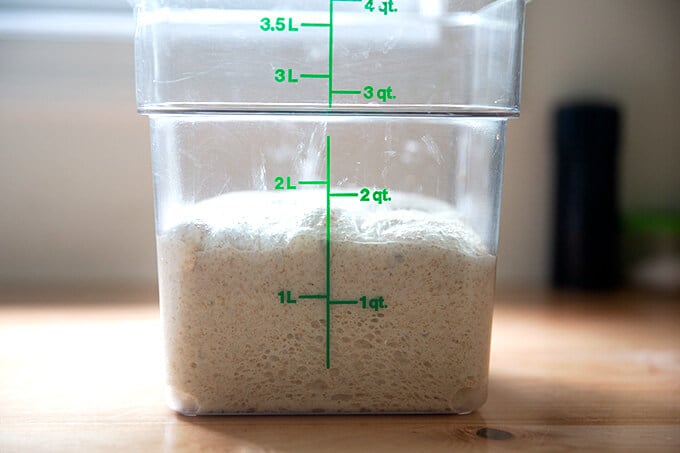
Shaping
Turn the dough out onto a lightly floured work surface:
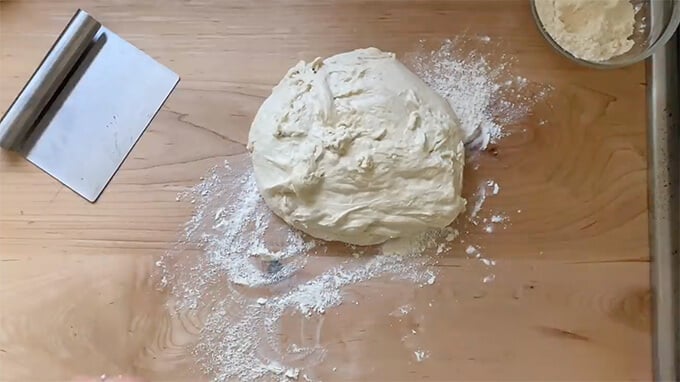
Shape the dough gently into a round and let it rest for 20-40 minutes. This is called the bench rest.
Meanwhile, prepare a bowl or banneton with a flour sack towel and rice flour.
Proofing
Shape the round again; then place in prepared bowl for proofing. Transfer to fridge for 12 to 48 hours.
Bake It.
Remove bowl from fridge, and turn it out onto a sheet of parchment paper.
Score it.
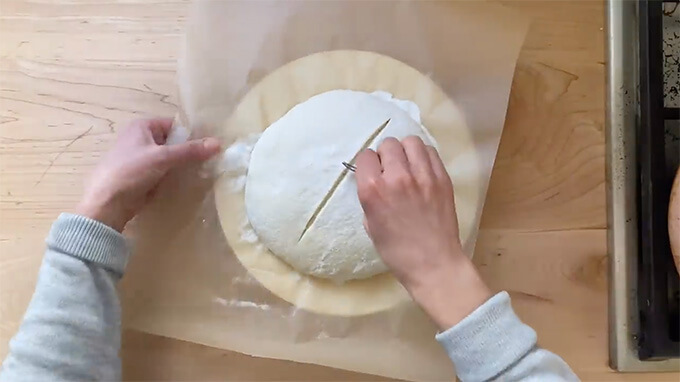
Transfer to preheated Dutch oven. Bake covered at 450ºF for 30 minutes; uncover, lower the temperature to 400ºF, and bake for 15 minutes more:
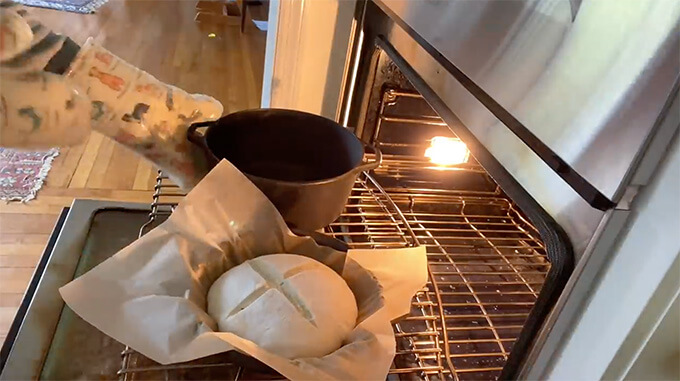
Remove from oven and let cool one hour before slicing.
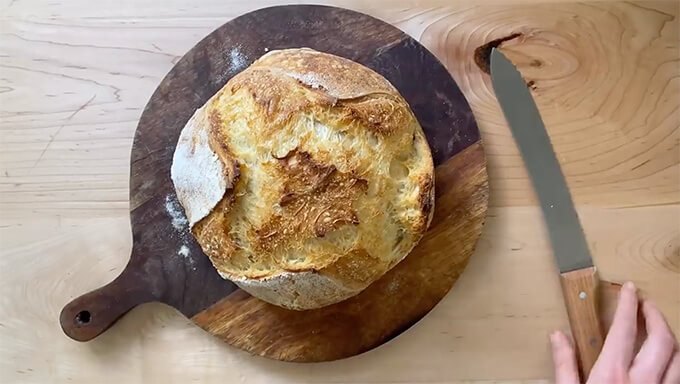
You’ll need a sharp knife (like this one or this one) when it’s time to slice:
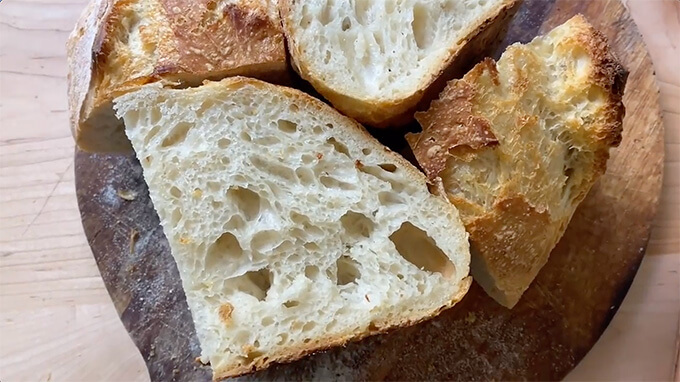
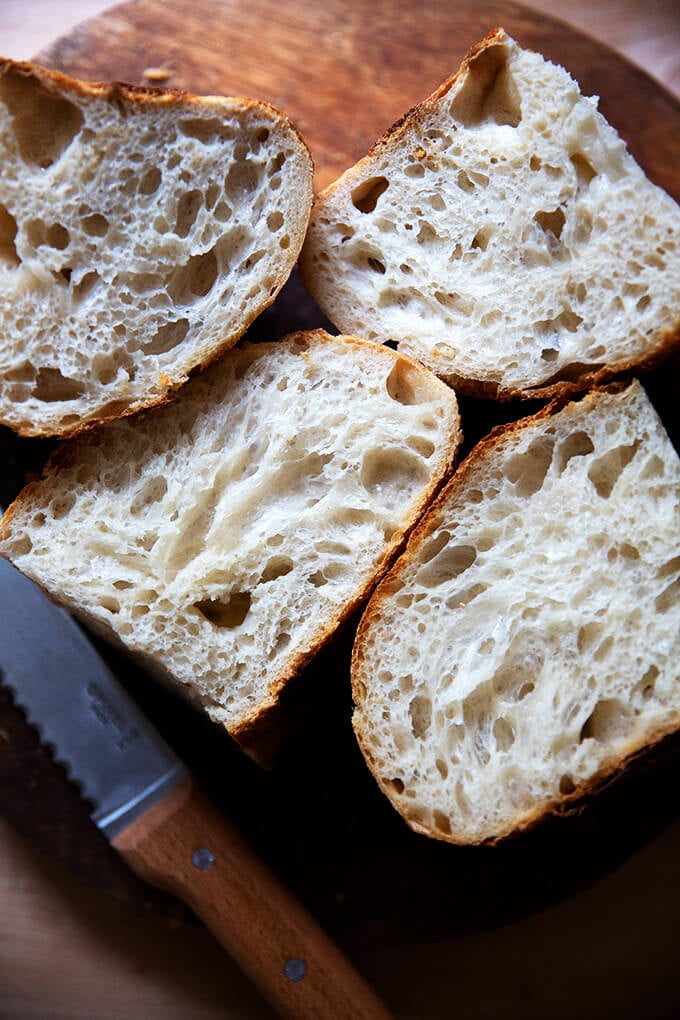
#1 Sourdough Bread Baking Tip
The refrigerator is your friend. Use it.
The most common mistake I see people make when making sourdough bread is letting the bulk fermentation go too long. They mix the dough at night; then wake up to dough that has tripled in volume and is a sticky mess.
To prevent over fermenting your dough, use your refrigerator as needed. After you complete the 4 sets of stretches and folds, you can put your dough in the fridge at any time. If you are tired and need to go to bed, transfer the dough to the refrigerator; then pick up where you left off in the morning: remove the dough from the fridge and let it continue to rise until it increases in volume by roughly 50%.
To accurately gauge when your dough has risen to roughly 50% in volume, I highly recommend investing in a straight-sided vessel such as this 4-qt Cambro (or this one, which is BPA-free!). When dough rises in a bowl, judging when it has risen sufficiently is tricky. There’s no question with a straight-sided vessel.

Troubleshooting: Where Sourdough Goes Wrong?
If you have ever had trouble baking sourdough bread, your issues likely stem from one of four places:
- Using a weak starter or not using starter at its peak.
- Using too much water relative to the flour.
- Over fermentation: letting the bulk fermentation (first rise) go too long.
- Using too much whole wheat flour, rye flour, or freshly milled flour.
I address each of these issues in this post: Why is my sourdough so sticky? 4 Common Mistakes, so please give it a read if you’ve had trouble with sourdough bread baking.
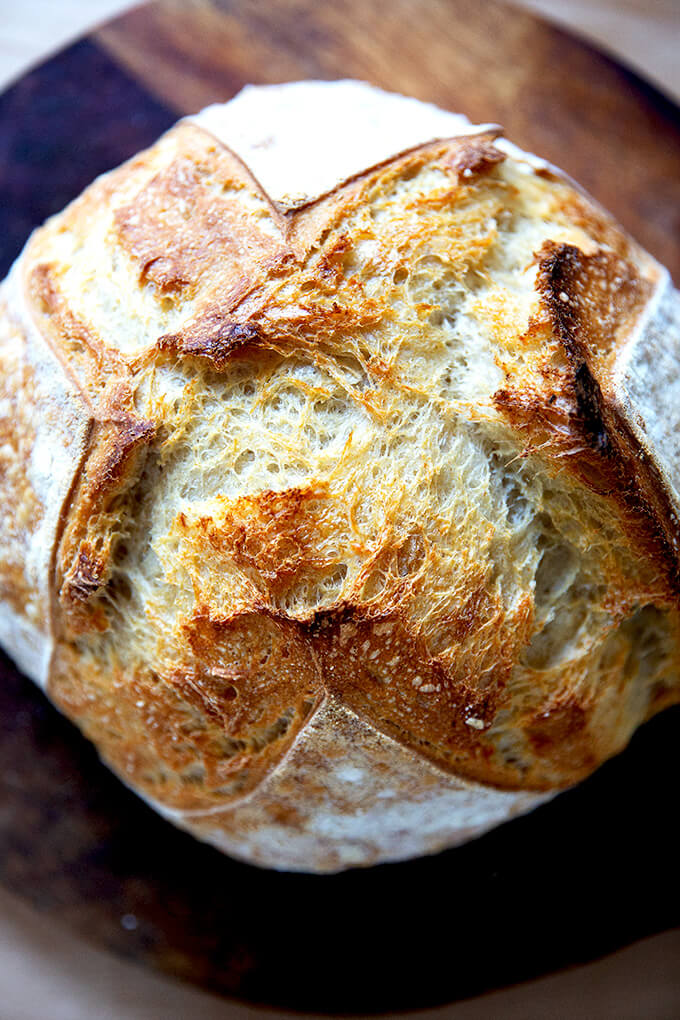
Sourdough Resources
- Sourdough Troubleshooting: This post addresses 4 common mistakes people make when baking sourdough bread and answers many FAQ’s as well.
- The Nutritional Benefits of Sourdough Bread + 6 Healthy Toast Topping Ideas
- Feeding Your Sourdough Starter
- Essential Equipment For Sourdough Bread Baking
- A tip for getting a more open crumb? Shape a batard as opposed to a round:
Other Sourdough Bread Recipes to Make
- Simple Sourdough Focaccia
- Sourdough Bread, Whole Wheat-ish
- Simple Sourdough Pizza
- Sourdough Detroit-Style Pizza
- Simple Sourdough Sandwich (or Toasting) Bread
- Sourdough Ciabatta
- Two Sourdough Discard Recipes: Sourdough Flour Tortillas & Irish Soda Bread
Sourdough Bread Baking Schedule
If you are new to sourdough bread baking, the timing of it all may feel overwhelming — you may find yourself asking: How can I do this without baking at midnight?
It’s a very good question! As noted above, your biggest friend when it comes to sourdough bread baking is your refrigerator. If after you’ve performed your stretches and folds, you don’t have time to stay up for the dough to complete the bulk fermentation, stick the vessel in the fridge and pick up where you left off the next day or the day after that.
Here is a rough schedule I like to follow. Adapt it to work for you:
Wednesday Evening: Remove starter from fridge. Feed it by discarding most of it and replenishing it with equal parts by weight flour and water.
Thursday Morning: Feed starter by discarding most of it and replenishing it with equal parts by weight flour and water.
Thursday Afternoon: Mix dough, let it rise. On Thursday evening, when the dough has completed the bulk fermentation, I’ll shape it and stick it in the fridge to proof. (As noted: If the dough hasn’t completed the bulk fermentation, I’ll stick the vessel in the fridge, and pick up where I left off the following day.)
Friday Evening or Saturday Morning: Score and Bake it. There is no need to let the dough come to room temperature before baking it. Simply remove it from the fridge, turn it out, score it, and bake it!
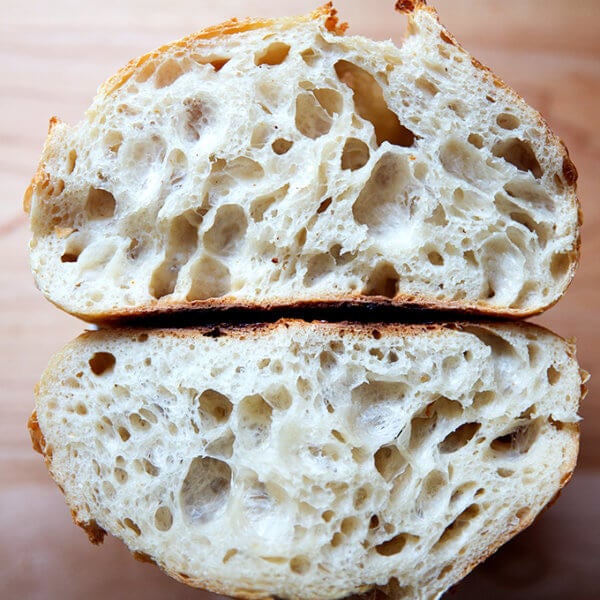
Homemade Sourdough Bread, Step by Step
- Total Time: 18 hours 45 minutes
- Yield: 1 loaf
Description
Inspired by The Clever Carrot
If you are new to sourdough, watch the step-by-step video here: Simple Sourdough Bread or in the post above.
Troubleshooting: If you have issues with your dough being too sticky, please read this post: Why is my sourdough so sticky? The 4 common mistakes.
Notes:
- You need an active sourdough starter. I have had success activating starters from:
- As always, I highly recommend investing in a digital scale before beginning any bread baking adventure.
- This is the Dutch Oven I use for sourdough bread. I used this Dutch oven for years, and it’s a great one, too.
- Flour sack towels are a great investment because they ensure your dough will not stick while it is proofing.
- I love using rice flour for dusting (as opposed to ap or bread flour) because it doesn’t burn. When you use a flour sack towel, however, you don’t need to use any flour.
- Find all of my sourdough essentials here: Essential Equipment For Sourdough Bread Baking
- I love a high-hydration dough, and I have great success using 380 grams of water in this recipe, so feel free to play around and push the hydration here.
- Salt: I have had success using both kosher salt and fine sea salt here. When I use kosher salt, I use the Diamond Crystal brand. When I use sea salt, I use the Baleine Fine brand. Regardless of the brand, I use 12 grams.
- Shaping: If you’re looking to get a more open crumb, try shaping a batard (as opposed to a round). Watch this video for guidance. Also: The recipe below follows the traditional shape once, rest, then shape again method. I often skip the preshape now and simply shape the dough once. I still get a nice open crumb.
How much Sourdough Starter to Use?
- Because my kitchen is cold for much of the year, I like using 100 g (1/2 cup) of starter as opposed to 50 g (1/4 cup). When determining how much starter to use, consider a few things: If you live in a warm, humid environment, 50 g should suffice. If you plan on doing an overnight rise, 50 g also should suffice. If you want to speed things up or if you live in a cold environment, consider using 100 g starter. Note: If you use 100 g of starter, your dough may rise more quickly, so keep an eye on it. As always, rely on the visual cues (increasing in volume by 50%) when determining when the bulk fermentation is done.
- A straight-sided vessel makes monitoring the bulk fermentation especially easy because it allows you to see when your dough has truly doubled.
Ingredients
- 50 – 100 g (1⁄4 – 1/2 cup) bubbly, active starter — I always use 100 grams, see notes above
- 375 g (1 1/2 cups plus 1 tbsp) warm water, or more, see notes above
- 500 g (4 cups plus 2 tbsp) bread flour
- 9 to 12 g (1.5 – 2.5 teaspoons) fine sea salt, see notes above
Instructions
- Make the dough: Whisk the starter and water together in a large bowl with a fork or spatula. Add the flour and salt. Mix to combine, finishing by hand if necessary to form a rough dough. Cover with a damp towel and let rest for 30 minutes.
- Stretch and fold: After 30 minutes, grab a corner of the dough and pull it up and into the center. Repeat until you’ve performed this series of folds 4 to 5 times with the dough. Let dough rest for another 30 minutes and repeat the stretching and folding action. If you have the time: do this twice more for a total of 4 times in 2 hours. Note: Even if you can only perform one series of stretches and folds, your dough will benefit. So don’t worry if you have to run off shortly after you mix the dough.
- Bulk Fermentation (first rise): Cover the bowl with a towel and let rise at room temperature, about 8 to 10 hours at 70°F (21°C) or even less if you live in a warm environment. The dough is ready when it has increased by 50% in volume, has a few bubbles on the surface, and jiggles when you move the bowl from side to side. (UPDATE: In the past I have recommended letting the dough rise until it doubles in volume. If you’ve had success with this, continue to let the dough double. Recently, I have been stopping the bulk fermentation when the dough increases by 50% in volume, and I feel I am actually getting better oven spring in the end.) (Note regarding timing: If you are using 100 g of starter, the bulk fermentation may take less than 8 to 10 hours. If you live in a warm, humid environment, the bulk fermentation may take even less time. In the late spring/early summer, for example, my kitchen is 78ºF and the bulk fermentation takes 6 hours. It is best to rely on visual cues (increase in volume by roughly 50%) as opposed to time to determine when the bulk fermentation is done. A straight-sided vessel makes monitoring the bulk fermentation especially easy because it allows you to see when your dough has truly increased in volume by 50%.)
- Shape (See notes above): Coax the dough onto a lightly floured surface. Gently shape it into a round: fold the top down to the center, turn the dough, fold the top down to the center, turn the dough; repeat until you’ve come full circle. If you have a bench scraper, use it to push and pull the dough to create tension.
- Rest: Let the dough rest seam side up rest for 30 minutes. Meanwhile, line an 8-inch (20-cm) bowl or proofing basket with a towel (flour sack towels are ideal) and dust with flour (preferably rice flour, which doesn’t burn the way all-purpose flour does). Using a bench scraper or your hands, shape it again as described in step 4. Place the round into your lined bowl, seam side up.
- Proof (second rise): Cover the dough and refrigerate for 1 hour or for as long as 48 hours. (Note: I prefer to let this dough proof for at least 24 hours prior to baking. See video for the difference in the crumb of a loaf that has proofed for 6 hours vs one that has proofed for 24 hours. If you choose to proof the dough in the fridge for an extended period of time, you may want to tuck it into a loosely tied bag — produce bags from the grocery store are great for this purpose — to ensure the dough does not dry out. The original recipe calls for a 1-hour rise, and if you have had success doing that, by all means, keep doing it.)
- Place a Dutch oven in your oven, and preheat your oven to 550°F (290°C). Cut a piece of parchment to fit the size of your baking pot.
- Score: Place the parchment over the dough and invert the bowl to release. Using the tip of a small knife or a razor blade, score the dough however you wish — a simple “X” is nice. Use the parchment to carefully transfer the dough into the preheated baking pot.
- Bake: Lower the oven to temperature to 450ºF (230ºC). Carefully cover the pot. Bake the dough for 30 minutes, covered. Remove the lid, lower the temperature to 400ºF (200ºC) and continue to bake for 10 – 15 minutes more. If necessary, lift the loaf out of the pot, and bake directly on the oven rack for the last 5 to 10 minutes. Cool on a wire rack for 1 hour before slicing.
- This loaf will stay fresh up to 3 days stored at room temperature in an airtight plastic bag or container. It freezes beautifully, too.
Notes
- This recipe has been adapted from Artisan Sourdough Made Simple. Changes I have made to the original recipe include:
- Using 11 g salt as opposed to 9 g.
- Performing 4 stretch and folds during the first 2 hours of the bulk fermentation, which build strength in the dough.
- Doing a cold proof for at least 24 hours before baking, which produces a lighter airier crumb. In the video, you can see the difference between the crumb of a loaf that has proofed for only 6 hours vs a loaf that has proofed for 24 hours.
- Finally, I like preheating my Dutch oven, which makes a crisper crust.
- Prep Time: 18 hours
- Cook Time: 45 minutes
- Category: Bread
- Method: Oven
- Cuisine: American
This post may contain affiliate links. Please read my disclosure policy.

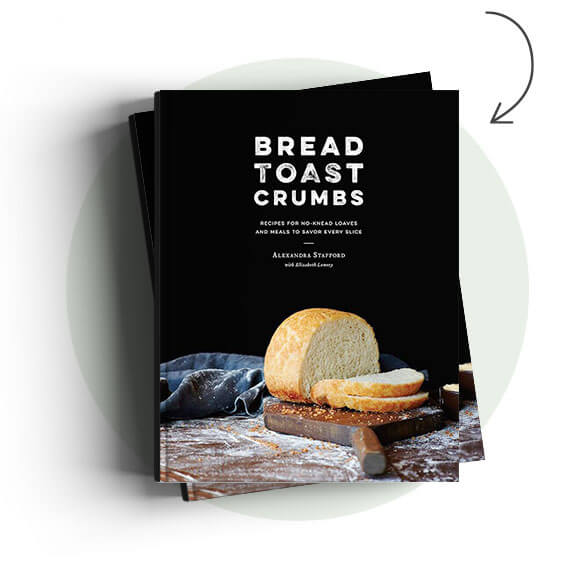




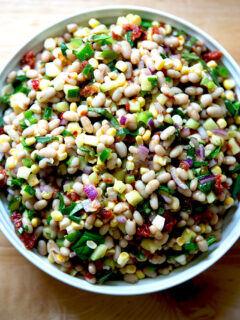
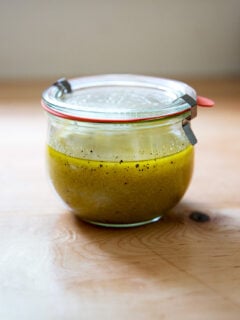



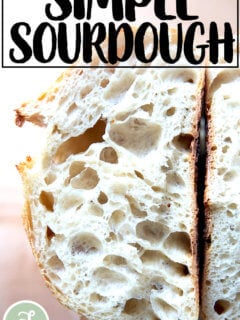
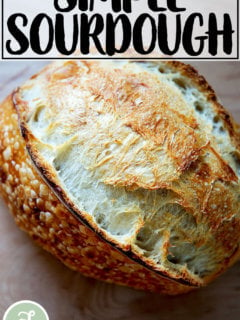
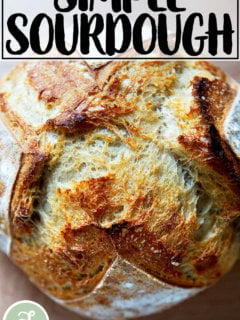
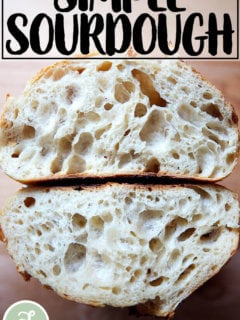
3,028 Comments on “Homemade Sourdough Bread, Step by Step”
Why does this not work for me???? My starter doubled in about 5 hours, so I assumed it was ready. Followed directions precisely. No rise at all during bulk fermentation period. Read some other online posts that had the same issue, but it rose during baking, so I carried on. Took out of fridge and put in oven. No rise. And after 45 minutes, loaf was still very pale. So I have a flat, dense, inedible loaf…again. 🙁
Hi Lisa,
Can you tell me about your starter? Is it homemade? And what type of flour are you using?
If you didn’t get a rise during the bulk fermentation, something is not right with your starter. I say this all the time, but it starts with your starter. This troubleshooting post might help.
Your directions are perfect. My very first loaf is amazing! I tried to share a picture but it didn’t work. Thank so much for this!
So nice to hear this, Julie! Thanks so much for writing. I wish I had a photo upload feature here … maybe one day. Enjoy your loaf 🍞🍞🍞🍞🍞
Hi thank you so much for your recipe. It was very easy to follow and I hope with some practice I’ll be able to nail it. This was my first sourdough loaf and I did have a bit of an issue. I let my dough bulk ferment for around 7.5 hours to when it had increased by 50% in volume. However, when I tried to shape my dough I found it was very wet and impossible to shape. I proofed in the fridge for 14 hours and baked anyway. My hopes were not high for a loaf considering my shaping issue, but surprisingly it did rise and looked ok (if I little ugly as I had been unable to shape and score) and actually tasted quite nice. However, the texture was gummy:
Could this be because:
– I used a rye starter that I am babysitting for a friend. I fed it and let it rise to double the volume but I didn’t use it until 24hrs after feeding
– I forgot to use warm water when I mixed the starter and water together. I used cold water straight from the tap.
Thanks in advance for the advice!
Hi Ella!
It sounds as though the dough over-fermented. Was the dough rising in a bowl or a straight-sided vessel? I ask because it’s hard to judge the percentage increase in volume in a bowl.
A very wet and impossible to shape dough is a sign of over-fermentation. The gummy texture also is a sign of over-fermentation.
It’s very possible the rye starter is contributing to the troubles … rye doesn’t have as much gluten, so a dough made with rye flour will have less strength. I see you are in the UK as well — was the dough very wet to begin with? You may want to reduce the amount of water over all.
Loved this recipe! I’ve tried crusty sourdough loaves like this before and never had success but between the videos, instructions, visual cues, and timing guidelines I was able to pull it off! I feel like I’ve hit the jackpot in my discovery of this blog- so many good recipes I can’t wait to try!!
So nice to hear this, Caroline 🙂 🙂 🙂 Thanks so much for writing and thank you for your kind words. Means a lot!
Hi Ali,
I’m baking here in the Netherlands, and what’s most available is regular flour with a protein percentage of about 11%. I’ve tried baking purely white sourdoughs in the past, and whether it was the hydration ratio or the flour, I’m not sure, but each time the boule couldn’t hold it’s shape at all and I couldn’t form it. Reading through what you’ve written, along with comments, I’m wondering if the bulk fermentation was the issue, but I wondered if it would make that much of a difference regarding the protein percentage (11% vs 12.3%) What do you think? Thanks so much for all the work you do in providing us with so much help!
Hi Samantha! I think you probably need to reduce the amount of water you are using. Try holding back 50-75 grams of water. You can always add it back in slowly if the dough seems dry. Reference the video for how the texture of the dough should be.
If after the bulk fermentation the dough was completely without strength and structure, however, it is possible that you over fermented the dough, so I might shorten the bulk fermentation next time around.
Good luck with your next go around. Let me know if you have any questions!
Thank you so much! This recipe worked amazingly I let it proof for 3 hours in the kitchen it was around 27 degrees. And it made the most beautiful loaf! Using my homemade starter. Will definitely make again soon X
Great to hear Emma! Thanks so much for writing and sharing 🙂 🙂 🙂
I have used this recipe so many times that I have it memorized. I am now able to teach my friends and family who are interested in sourdough bread making the process from start to finish and help them to troubleshoot along the way. Thanks for the great recipe and thorough instructions!
So nice to read all of this 🙂 🙂 🙂 Thank you so much for writing and sharing all of this. I love hearing about bakers teaching others how to bake. Such a gift!
Fabulous instructions, worked the first time. Rather than time everything I watched for the sign; doubled in 2 hours. Delicious bread! Thank You!
Great to hear Terry! Relying on visual cues is the way to go 🙂 🙂 🙂
Finally! My last several loaves have been utter failures. THIS method seems to be the right one for me and my precious starter, Saoirse! Thank you for all the little ideas and tweaks. Loaf 1 down, a lifetime’s worth to come.
I birthed my starter from scratch in Fall 2020. I have fed it regularly and split off portions to experiment with feeding different flours (whole wheat, all purpose, organic, local, etc.). My ingredients are kept in a temperature controlled room, including my filtered water. I use a digital scale each time.
One adjustment I regularly employ is adding a bit of sugar to my dough. I will continue to adjust proofing times and temperatures.
I cannot wait to create a noir loaf with this foundation.
So wonderful to hear all of this, Amy! Thanks so much for writing and for sharing your notes. Can’t wait to hear what else you and your precious Saoirse produce!
The recipe worked out perfectly! Using a kitchen scale was the game changer.
Doesn’t a scale change everything? Thanks so much for writing. Great to hear!
Hi Alexandra, yep questions for you please.
1. Do you ever get a skin on your dough after the bulk rise? If so, do/should you cut this off? Any recommendations to prevent it? I’ve been putting my proofing basket insert over the top of my straight sided vessel.
2. How do you manage weighing your starter in your quart jar before feeding it? I feel like I have to dump it out, clean the jar, then add in a certain amount of starter so I can accurately feed it with the correct gram weight of flour and water. Is there an easier process to this you could recommend or is that just the nature of the beast? Thanks again so much, hope that made sense.
Hi Anne,
Sometimes I do get a skin, but I’ve learned that when it’s really dry out, often in the winter, instead of using a cloth bowl cover, I use a lid that seals. If the skin is on the thin side, you shouldn’t have to cut it off… it should reabsorb into the dough. If it feels very thick, you can remove it.
Regarding feeding my starter, I simply dump out most of it, and I don’t worry about the weight of what’s left in my quart container. Then I place my quart container with the remaining starter in it on the scale, tare it, then feed it with equal parts by weight flour and water.
Does that make sense?
Thanks so much for the quick reply.
Yes, I believe that makes sense – you’re saying the gram weight of the starter does not really matter, just the equal weight of the flour and the water. This will definitely make it easier going forward, thank you! 😅
Exactly! Sorry for the delay here. Hope your starter feedings have been easier 🙂 🙂 🙂
This recipe is a game-changer! I didn’t have Bread Flour on hand, so swapped for Unbleached, All-Purpose and it came out phenomenal. It takes time and patience, but totally worth it. The bread came out crispy on the outside and fluffy on the inside. I can’t believe I just made this myself at home. Thank you for carefully walking us through this and for the great recipe, Alexandra!
So nice to hear this, Loryne 🙂 🙂 🙂 Thanks so much for writing. Great to hear ap flour worked, and I’m so happy you were pleased with both the crust and crumb. Patience is key!
Thanks Alexandra! Recipe has been working like a charm in terms of flavor and consistency, but I don’t know what I’m doing wrong in terms of not getting enough rise once it’s in the oven. I’m trying to cut down the bulk fermentation time but is there another reason this could be happening? Thanks in advance!
Hi! You could try bread flour … it does sometimes make for a loftier loaf. How long are you cold proofing for? And are you using your starter at its peak? As in, does it feel very active and bubbly when you go to use it?
I am about to try making my first loaf, but I don’t have a Dutch oven. I have a Pullman loaf pan – what adjustments do I need to make? Since I won’t be snapping it into a round dome?
Hi! Why don’t you try this recipe instead: Easy Sourdough Sandwich (or Toasting) Bread
Hi Ali … I finally have cubes for the bulk fermentation. I’ve made this recipe several times with a bowl during bulk with good results but feel nervous each time that I might go too far with fermentation.
I’m excited to use the new cubes!
Question: All other sourdough bakers I follow say to never let salt come in contact with the starter. So their mix the salt with the flour first, before adding starter and water — and then they mix the dough. You add the salt right in with the water and starter. Honestly, I’ve shied away from yours method and still stick with mixing the salt into the flour before introducing the starter.
I’m so curious to know why you do this. I’ve made many of your recipes with great results. This one small detail in your sourdough bucks the other sourdough teachers’ recommendations. Any thoughts?
Thanks 🙏
Anthea
Hi Anthea!
I’ve just never felt that the autolyse in the end is worth the trouble. I really really dislike the process of adding salt and water after the initial mixing — I find it tricky and messy and just a pain. With all of my sourdough bread recipes (and yeast bread recipes), I mix everything all at once, and I’ve never had an issue. I suggest skipping the autolyse, and if you are disappointed with the results, you can always add that step to your process.
Hi Ali …
Thanks & sorry about that! I was unclear.
What I do is add everything together all at once as you show in the video — & like the 2 other sourdough bakers I follow do. However, I change your order as follows:
– I mix the flour & salt with my fingers in the mixing bowl then …
– I add water to the flour & salt, & then …
– I add the starter & mix everything
From there I follow your instructions in your video.
It’s the starter & salt *alone* together in the water that I’m curious about. Doesn’t the salt negatively impact the starter? The other bakers I follow stress keeping salt & starter somewhat separate.
🤔🙏
ok, got it! Not for me… I’ve never had an issue with salt negatively impacting the starter. I see lots of bakers stress out about whisking instant yeast, flour, and salt together as well, but I’ve never had an issue there — I whisk them all together all at once. I mean, if you think about it, if you add the salt to the water with the starter and then add the flour it’s really not much different than whisking the flour with the salt then combining it with the water and starter — all components unite eventually. But if it makes you nervous, you can whisk the salt and flour together; then proceed.
Hi Ali …
I’ve been using your Simple Sourdough video recipe all this time & just read through the entire written recipe here while my dough is waiting for a final stretch & fold.
Why are your measurements for flour, water, starter & salt so much different here than in your video of the very same recipe? Is one recipe better than the other? I’m confused. Should I try this recipe next time?
Thanks,
Anthea
Hi! I have two simple sourdough bread videos: one has 400 grams flour and one has 500 grams flour. The one embedded into this post should be 500 grams flour and should match the recipe. I’ll double check right now. The 400 gram flour recipe matches this recipe: Easy Sourdough Bread (Whole Wheat-ish) I do actually prefer the 400 gram flour recipe with some whole wheat flour in the mix, but it’s a teensy bit higher hydration, which makes it a little harder to work with. This recipe here is the one I recommend for beginners because it’s a bit more foolproof.
That explains it. I didn’t realize you have 2 videos & recipes for simple sourdough. I’ll stick with the easier version for beginners. Thanks again Ali, & thanks as well for explaining your “when to add salt” method in the other post.
Hi Ali,
I’m dying to figure out why my loaves seem to be less and less airy and open, after good success earlier on. The more experienced I’ve become, the denser my loaves are turning out.
I recently tried another baker’s simple sourdough recipe that adds some rye flour instead of wheat, as your’s asks for some wheat (the wheatish sourdough version). Since I have organic rye flour on hand I decided to go with the other baker’s recipe. The process is identical to your process aside from the measurements (they are close however).
The loaves came out way too dense. It might be because I regularly feed my starter with rye flour which creates a very thick, very active (dry feeling) starter.
I see your starter is thin and liquid in comparison to mine — it looks quite wet — which I presume makes a difference in the hydration of the dough. Using my very thick rye-fed starter is likely affecting the dough hydration. Maybe I need to add more water.
I’m experimenting today with 2 starters — one fed with King Arthur Organic Bread Flour (thin & wetter) and one fed with Fairhaven Mills Organic Rye Flour (thick & dryer). I’ll use those to make your Simple Sourdough (500 grams of flour – instructions above) loaf. I want to see how the different starters impact the openness of the crumb.
This is driving me up the wall, especially since my early loaves a year ago using your other beginner sourdough recipe had a more open crumb than my current loaves. I used the version with 400 grams of flour following only your video instructions (no written version that I could find then). The video is here:
https://m.youtube.com/watch?v=0uwnasygzLk&list=PLJFIJmaAIRJmeG6Onb1eEvA5XJqHLJE7v
And this is confusing:
The title says: Simple Sourdough Bread (Whole Wheat-ish) : A Step-by-Step Tutorial” but there is NO WHOLE WHEAT mentioned in the video tutorial. It just says “400 of bread flour” at the top of the screen. I followed the link in the body of the YouTube video which is here:
https://alexandracooks.com/2019/11/07/easy-whole-wheat-ish-sourdough-bread/
When I clicked on “jump to recipe” again the recipe on your blog titled “Easy Sourdough Bread (Whole Wheat-ish)” lists NO WHOLE WHEAT flour in the recipe text.
My apologies for more questions, but I really do want to figure out what I’m doing wrong after my early successes. It seems it might be a combination of my dryer rye starter making for a denser loaf and the different measurements on your video vs on your blog. I still haven’t found your recipe that actually includes some whole wheat flour in the recipe (although it’s in the title).
Thanks again for any help you can offer,
Anthea
Hi Anthea,
I think the rye flour is making the loaves dense. You could try adding more water, but rye has less gluten, so the more rye flour you use, the denser the bread is going to be.
Regarding the Whole Wheat-ish recipe, I kept it to 400 grams bread flour for simplicity, but then said “see notes above” so that people can make their own decision about how much whole wheat flour they want to use. Here’s what the note says:
• I prefer making this bread with 350g bread flour and 50g of freshly milled, stone-milled flour, which provides both flavor and color. (Read the post above for more details and why I suggest stone-milled flour as opposed to commercial whole wheat flour.) I’ve been using a mix of Anson Mills graham flour and rye flour, but there are many great stone-milled flours out there, and you may have a local source, which is even better.
• 50g may seem like a tiny amount of stone-milled flour for this recipe, but I am constantly amazed by how much flavor this small amount of freshly milled flour adds. If you are new to sourdough baking, I recommend starting with 100% bread flour (King Arthur Flour is my preference) because it’s so forgiving and easy to work with. Once you get the hang of it, start incorporating stone-milled flour a little bit at a time. I don’t like using more than 100g (25%) of stone-milled flour in this recipe.
Hope that helps!
Hi Ali,
I’m responding to your March 11 reply to my questions re: rye’s impact on my sourdough.
Thanks so much for this and for including the*note* that was above the recipe which I somehow missed. I clicked “skip to recipe” & went to town.
I read through all your bread making tips on your blog over a year ago when I was looking for ways to increase the sourdough flavor. Then I made YOUR sourdough (not the wheat’ish recipe) when my skills improved. I used your YouTube video only, not adding any wheat flour as that wasn’t the wheat’ish recipe. I used all King Arthur Bread Flour and fed my starter with KABF from the beginning. That worked great! I used your recipe after getting good at Patrick Ryan’s Sourdough Masterclass YouTube tutorial/recipe which is a lower hydration sourdough for beginners and uses kneading rather than the stretch-and-fold method.
Then — when my loaves were good every time — I started experimenting by using fresh milled rye to feed my starter as suggested by Patrick Ryan in his Masterclass.
None of the 3 bakers I follow have mentioned that the type of starter makes a difference too. I just discovered this last week when I did an experiment. I divided my 100% rye starter & fed half with King Arthur Bread Flour & the other half with 100% rye flour. Both were super active but clearly the KA-fed starter rose more quickly & was far wetter than the rye-fed starter. I made 2 loaves using your sourdough YouTube recipe (400 grams/no wheat added). One loaf I made with KA-fed starter & the other with rye-fed starter. Wow! There was an obvious difference! The KA-fed starter made the dough wetter than the rye-fed starter dough — I could feel it when stretch-and-folding side by side.
And the results fall in line with your suggestion that rye makes the loaves denser, even though no rye flour was added to the recipe itself. It was all KABF. The only rye was in the starter. The rye-fed starter loaf was more tangy, had a denser crumb, and rose less when baked. The KA-fed starter loaf had a very open crumb and rose nearly an inch higher than the other loaf.
This is a big deal for me! My loaves changed (rose less & were denser) right when I changed to rye-fed starter. My take-away is the flour we feed our starter with makes a HUGE difference. Next time I’ll try using a KA-fed starter to make your wheat’ish sourdough & see what happens.
Thanks, Ali, for taking time to respond to my various & sometimes bizarre questions. 🙂
Anthea
Not bizarre at all! You wouldn’t think that 50 grams of flour in a 100-gram portion of starter could affect a dough so dramatically, but it does. Thank you so much for taking the time to experiment so methodically and to share your results here — so helpful for others. I think you might be happy with the 400 gram whole wheat-ish recipe using your bread flour starter and 50 grams of rye flour 350 grams of bread flour. Also, I’m not sure what type of rye flour you are using, but you might that if you get a freshly milled stone milled bag of rye, it will offer a tremendous amount of flavor, so you’ll get a nice tang while not making the loaf completely dense.
Hi there!
I cannot Wait to try your method!
What a superb, superb way you have written this recipe out – Yes, yes and Yes!
Thankyou!
Cathy x
Hi Ali ~
I made the sourdough bread. It came out fine–but the taste is ‘blah”. What could I do to get more flavor?? I will probably use it as croutons. I like whole wheat sourdough…but this loaf is so bland –simple sourdough. (I was hoping for a San Francisco sourdough “WOW” bread..didn’t get it..
Joanne C
galloclark18@gmail.com
Hi Joanne! How long did you cold proof your dough? And are you using a scale to measure? My initial thoughts are to increase the length of the cold proof it was 24 hours or shorter and to increase the amount of salt. You could also try this recipe, which is the one I actually prefer: Easy Sourdough Bread (Whole Wheat-ish) It’s slightly higher hydration, and I use some freshly milled whole wheat flour.
Hello there! This process has been so easy and seamless! Thank you for the easy instructions AND videos!
My question is regarding the bulk fermentation. I’ve waited until it’s risen 50% however the bubbles are only on the bottom of my container and it doesn’t really jiggle when moving it. It is in an upright container rather than a bowl. Should I wait until bubbles are throughout the entire dough? Would love your input!
Hi! It should be fine! I would proceed and shape the dough; then cold proof for at least 24 hours before baking. What did you end up doing? Apologies for the delay here!
I thought it turned out great! Taste was wonderful!
I think it didn’t rise as much as it should by others standards, but I was so proud of it and grateful for your input!
Great to hear, Nicole! Thanks for reporting back 🙂 🙂 🙂
I am new to sourdough and made this recipe twice. The first time it came out great. Somehow I missed the refrigeration stage and it came out light airy. The second time I put it in the fridge as suggested in the recipe. It ended up being a much denser bread. Good flavor, but not light like the first time. I used a straight razor to try to make a design, but that was an epic failure. Any suggestions?
Hi Leslie! It sounds as though your dough may have overfermented the second time around. Do you remember how long the bulk fermentation was? And did the dough feel strong and elastic when you shaped it before transferring it to the fridge?
Also: sourdough is all about finding your rhythm and method. If you don’t want to do the fridge rise, you can skip it and do the method you have success with.
I find I get the best results when I let the dough bulk ferment to 50-75% increase in volume; then shape; then cold proof for 24-48 hours. But there are many many ways of getting to a great loaf of SD bread. So do what you like.
Love this recipe! Used this to make wonderful SD many times. I am wondering if there is a way to make this using all purpose flour instead of bread flour?
Definitely! You may need to reduce the water slightly, but otherwise, I would try simply using all purpose flour without making any changes first.
I love this recipe! I’ve been making it once or twice a week for the past few months and almost always turn out a great loaf! My question is, if I want to make two smaller loaves, what adjustments would I need to make to the bake time? Thanks!
Hi Katthy!
I would keep the temperatures the same but change the time: try 20 minutes covered; then uncover and bake until it’s browned to your liking… 15 minutes or so.
Made this recipe for the first time this weekend it was delicious! When I first mixed my dough it did seem a little wet so I added a touch more flour and it came together nicely. That may have been my own fault though because I hate mixing by hand so I used my stand mixer which may have something to do with it! I also let my dough bulk ferment for over 12+ hours (it may have been closer to 16.. I can’t remember what time I mixed it together) and it still turned out perfectly fine! I was scared it would overproof and be a goopy mess but that was not the case!! I was going to my friends immediately after I took it out of the oven so I took the loaf with me and we were counting down the minutes until an hour passed and we could cut in to it… totally worth the wait!
So nice to hear all of this, Devyn! Thanks so much for writing and sharing your timing notes — so glad your dough didn’t overferment, and yay for having friends to share freshly baked sourdough with 🙂 🙂 🙂
Thank you so much for this recipe and all the helpful hints and tips. I recently re-located to Sakhalin, Russia for my husband’s job and decided to get back into sourdough baking (not a lot to do here). My first attempts a couple years ago were fine but not great. I recently found your post and your tips about 50% bulk fermentation and 24-hour cold proof were total game changers. I am finally producing the loaves of my dreams! Thank you for creating such a straight forward, easy to understand, and immensely helpful guide to sourdough bread baking.
So wonderful to hear all of this, Nguyet! Thanks so much for writing. So glad you’re finding success 🙂 🙂 🙂
This recipe is the perfect amount of work vs. return on the loaf for me. I like simple sourdough recipes with minimal hands-on time. It’s just fantastic to spend one morning working on the dough and then just letting it chill for 2 days. Thanks so much for developing this!
So great to hear this Mary Beth! Thanks so much for writing. I, too, love that I can make a loaf of this and have it hang out in the fridge for a few days until I’m ready to bake. So convenient 🙂
Directions say to cover and refrigerate. Does this mean just cover with the cloth that is in the proofing basket or are we also to cover entire basket with plastic and secure? Thanks
Good question, Lisa! I need to edit the recipe. When I was first making this, I always just wrapped the dough in the flour sack towel, which works for me. Some people find the dough dries out a bit, so I now recommend tucking the whole wrapped boule/basket into a plastic bag — like a produce bag and tying a knot.
Worked great thank you!!!!
Great to hear, Jenny! Thanks for writing.
Hi Ali,
After trying a few different sourdough recipes I now have stuck with your one as I find it is the one I like best 👍
Just a question on something I have read.
I have read that you can use an un-fed starter in a sourdough recipe but the overall process will just take longer (as in bulk fermentation).
What is your opinion on this?
Thankyou so much for this Wonderful Sourdough Recipe!
Cathy x
Great to hear, Cathy! I think what you have read is accurate. And it makes sense. I have used starter that is not quite as active as I would like, and the process as a result has taken longer.
I always advise using active starter mostly because it’s such a long process as it is, that you may as well get off on the right foot. Hope that makes sense!
Thankyou Ali dot answering my question! That makes a lot of sense!
Thankyou very much
Cathy x
I wonder if a Le Creuset Dutch oven will work? Although it does not have a flat lid as the one you suggested.
I have not tied making this yet, I am new to baking bread and I am a bit intimated. I just tried to make your mom’s Shepherds Bread, looks good as it is cooling.
Many people use Le Creuset Dutch Ovens! I find mine gets pretty discolored, which is why I prefer using cast iron. The peasant bread is wonderful… definitely start there!
Hi Ali,
Totally new to SD / bread making. I have created my own starter. Used as per your instructions. Where I am finding I may be losing my dough is when I put in the fridge it just seems very flat. When I watch you shape your dough prior to going in the fridge it is beautiful and moves and has elasticity. Not sure I’m getting that so then I put in fridge and it just seems to go flat.
My question is, is it that it’s my starter? Is it I am not letting it rise long enough during the stretching? Or do I need more time in the fridge? I originally left if in the fridge about 12 hours.
Also, if I take out of the fridge and it seems flat, can I let it rest at room temp to see if I can get it to rise some before backing?
All trial and error but your recipe seems to be the best fit for me so far, so I thank you!
Sorry for sooo many questions!
Kim
Hi Kim! No worries about the questions 🙂
I am worried your starter isn’t quite strong enough. Question: after you feed it, how long does it take to double or triple in volume? And with what type of flour are you feeding it? And is it equal parts flour and water?
I think once you strengthen your starter, the rest will fall into place. Unfortunately, if your dough is flat when it goes in the fridge, it will be flat when you bake it.
When you do the bulk fermentation, does the dough rise to nearly double (or less) in volume?